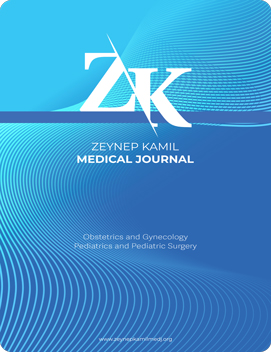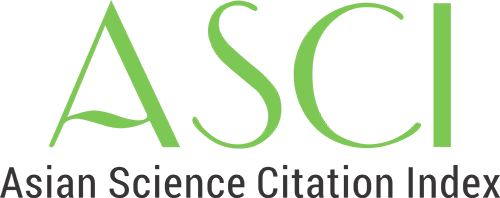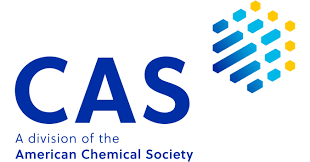Quick Search
Volume: 46 Issue: 3 - 2015
| LETTER TO THE EDITOR | |
| 1. | Catastrophic Uterine Rupture: Retrospective Analysis of Eight Cases in Rural Area Mehmet Baki Şentürk, Mehmet Şükrü Budak, Serap Otçu, Ömer Birol Durukan, Mesut Polat doi: 10.16948/zktb.15228 Pages 93 - 94 Abstract | |
| ORIGINAL RESEARCH | |
| 2. | Evaluation of Myomectomy During Cesarean Section Tülay Şahandar, Meryem Eken, Emin Erhan Dönmez, Ebru Çöğendez, Taylan Şenol, Mustafa Eroğlu doi: 10.16948/zktb.03375 Pages 95 - 99 INTRODUCTION: In our research we aimed to evaluate intra-operative and post-operative risks and complications of myomectomy cases under the guidance of literature, during cesarean delivery in our clinic and we targeted to foresee the approach to recurring myoma cases. METHODS: In our clinic between September 2010 and January 2014, data from 31 patients myomectomy during caesarean delivery (C/S) for relevant indications was compared retrospectively to the data of the control group consisting of 75 patients who only C/S. Placement, size and pathology reports of the myomas were recorded as well as the demographics characteristics of the patients. Groups were evaluated by the following parameters: Pre-operative and post-operative hemoglobin and hematocrit,duration of the operation, hospitalization interval, return of bowel function, postoperative fever (>38oC), blood transfusion requirement, bleeding volume during operation (milliliters), pre or post-operative hysterectomy and follow up surgical intervention. RESULTS: There is no significant difference between the demographic characteristics of two groups in terms of age, gravidity, parity, gestational age and history. Neither of the groups have a statistically significant difference between pre-operative hemoglobin (Hb) and hematocrit (Hct) count. (p>0.05) Post-operative Hb and Hct median count was not statistical difference between two groups was observed. There was no difference between two groups for pre-operative bleeding amount. Research group of myomectomy cases had longer operation time and late return of bowel functions. There was no significant difference between two groups for their duration of hospitalization interval. DISCUSSION AND CONCLUSION: There is no significant differences between patients who myomectomy during C/S and the control groups, except the operation time and later return of bowel functions. It was concluded that myomectomy during C/S would not cause any complications when if the patients are well assessed and the operation is carried on by an experienced surgeon. Extensive prospective studies with control groups are necessary for better assessment. |
| 3. | The Effect of Intrahepatik Cholestasis of Pregnancy on Maternal and Perinatal Outcomes Mehmet Bayrak, Taner Günay, Cihan Karadağ, Zelal Balçık Pages 100 - 105 INTRODUCTION: To evaluate maternal and perinatal outcomes of the pregnancies complicated by intrahepatic cholestasis of pregnancy and to discuss the appropriate pregnancy management. METHODS: Maternal and fetal characteristics were analyzed from the medical records of 32 patients who gave birth following a pregnancy complicated with intrahepatic cholestasis of pregnancy between January 2009 and December 2013. RESULTS: A total of 32 patients with intrahepatic cholestasis of pregnancy were enrolled the study. Diagnosis of intrahepatic cholestasis was made at an average of 34.15±3.1 gestational weeks and mean gestational time at birth was found to be 37.4±1.86 gestational weeks. Preterm birth rate (<37 gestational weeks) was 20.59%. Mean birth weight and a low (<7) 5- minute APGAR score were 2980±480g., and 14.70%, respectively. Meconium was detected in amniotic fluid in 14.70 % of the cases and admission rate to neonatal care unit was 12.50 %. There were no reported cases of stillbirth. The incidence of gestational diabetes mellitus in intrahepatic cholestasis of pregnancy was 15.62%. DISCUSSION AND CONCLUSION: Our data confirm an increased risk of preterm delivery in intrahepatic cholestasis of pregnancy. The high rates of gestational diabetes mellitusis need to be considered in the management of intrahepatic cholestasis of pregnancy. |
| CASE REPORT | |
| 4. | Leiomyoma with Massive Lymphoid Infiltration: Case Report Ecmel Işık Kaygusuz doi: 10.16948/zktb.17453 Pages 106 - 109 Massive lymphocytic infiltration of the leiomyomas of the uterus is rare and causes diagnostic difficulties. The pathogenesis of this lesion is not clear. The recognition of its distinct histological features is important to avoid possible confusion with differential diagnosis including malignant lymphoma. Only 20 cases have been reported in the literature. We present a case of leiomyoma of the uterus with massive lymphocytic infiltration, and we investigated the literature. |
| 5. | Unilateral Live Twin Ectopic Pregnancy: A Case Report Evrim Bostancı Ergen, Ayşen Boza, Mehmet Baki Şentürk, Semra Kayataş Eser doi: 10.16948/zktb.97761 Pages 110 - 112 Twin ectopic pregnancy is a rare condition with an incidence of 1 in every 200 ectopic pregnancies. We present a case of a twin, live, unilateral tubal ectopic pregnancy treated with laparoscopic salpingectomy. |
| 6. | Successful Management of Pregnancy In Non-Cirrhotic Portal Hypertension: A Case Report Yusuf Çakmak, Mehmet Baki Şentürk, Ertuğrul Yılmaz, Mustafa Eroğlu, Özgür Aydın Tosun doi: 10.16948/zktb.39119 Pages 113 - 115 The co-existence of pregnancy and liver disease is considered to be a rare and complex clinical situation. Besides pregnancy has specific complications even in a healthy liver, the previous liver damage associated to portal hypertension develops additional risks as a result of marked hemodynamic disturbances. |
| ORIGINAL RESEARCH | |
| 7. | Risk Factors of Pulmonary Hemorrhage in Preterm Infants Elif Özalkaya, Hande Özgün Karatepe, Sevilay Topçuoğlu, Emre Dinçer, Güner Karatekin, Fahri Ovalı doi: 10.16948/zktb.38501 Pages 116 - 119 INTRODUCTION: To determine the frequency and the risk factors of pulmonary hemorrhage ın preterm infants. METHODS: In this study 37 preterm infants hospitalized between January 2012 to January 2015 with the diagnosis of pulmonary hemorrhage and less than 28 gestational weeks were evaluated retrospectively. 233 preterm infants whose birth weight and gestational week are similar to study group and without pulmonary hemorrhage are taken as control group. Antenatal and postnatal medical records evaluated retrospectively. RESULTS: No difference have been showed between study groups for gender, cesarean delivery, multiple pregnancies, intubation in delivery room, preeclampsia, premature rupture of membranes, maternal use of corticosteroids, patent ductus arteriosus and early onset sepsis. Newborns who had pulmonary hemorrhage had respiratory distress syndrome and received surfactants more frequently than the control group. DISCUSSION AND CONCLUSION: In this study whether the increasing risk factor of pulmonary hemorrhage is because of RDS or treatment of surfactant has not been revealed. There needs more study to reveal the relationship between pulmonary hemorrhage and surfactant treatment. |
| CASE REPORT | |
| 8. | A Rare Complication Seen In A Child With Asthma: Subcutaneous Emphysema Mahmut Doğru, Nil Aras, Hümeyra Yasar doi: 10.16948/zktb.96461 Pages 120 - 122 Isolated subcutaneous emphysema due to bronchial asthma is a rare disorder which is often seen with pneumomediastinum. Subcutaneous emphysema is often seen with asthma attacks. Besides it may be a self-limiting disorder, it may also be life threatening. |
| ORIGINAL RESEARCH | |
| 9. | Is it Possible to Predict Survival in Cases with Congenital Diaphragmatic Hernia? Alp Gence, Ayşenur Cerrah Celayir doi: 10.16948/zktb.58066 Pages 123 - 128 INTRODUCTION: This study was planned to determine whether there is a correlation between diagnosis criteria and survival and morbidity rates and to show the importance of blood gas values taken in the first 24 hours with a view to prognostic survival predictions in newborns with CDH treated and followed at our department. METHODS: This study was carried out prospectively covering newborns with CDH treated and followed between January 2006 and May 2009. For the gathering of data; demographic features, diagnostic time (prenatal/postnatal), all findings of laboratory and radiology, treatment characteristics, early stage post-operative complications, and results were evaluated. RESULTS: 37 newborn with congenital diaphragmatic hernia were hospitalized, followed and treated at our department during 29 months period. 18 were female (48.6%) and 19 were male (51.4%). Prenatal diagnosis was made in 30.3%. Ultrasonography showed polyhydramnios in 5 out of 15 cases (41.6%) diagnosed prenatally and polyhydramnios with intrathoracic stomach in 3 cases (25.1%). Spontaneous delivery was happened in 54.5%. Hernia was on the left side in 72.7% of the patients, and 21.7% of patients had involved major anomalies. The difference between dying and surviving cases was found statistically significant according to 1st and 5th minute APGAR scores, and MAP, VI, MVI, OI, PIP values, and existence of major anomalies. DISCUSSION AND CONCLUSION: This study demonstrated that the prenatal diagnosis before 25th week, existence of major anomalies, 1st and 5th minute APGAR scores, PIP, OI and MVI values may be used in order to make a prediction as a prognostic factor in cases with CDH. Although statistically significant relationship between the mortality rate and polyhydramnios and/or prenatal diagnosis and survive were not significantly; lower than 40 of the MVI was found to be helpful in positive predicting on survival of cases with CDH. |
















